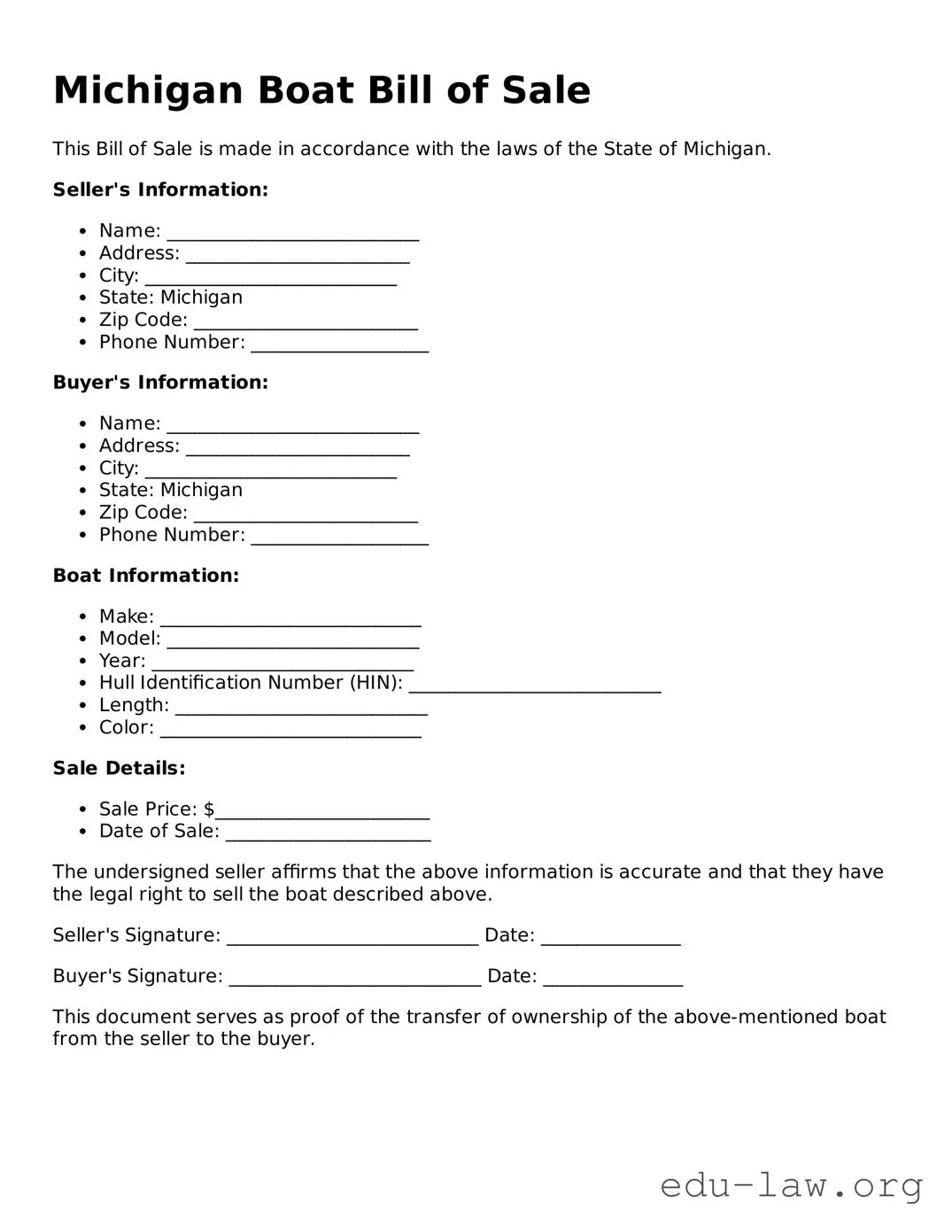The Michigan Boat Bill of Sale form is reminiscent of the automobile bill of sale. Both documents serve as proof of transfer of ownership, detailing the specifics of the transaction such as the buy and sell price, vehicle identification numbers, and the names of both parties involved. Just as a car's sale requires documentation to ensure a clear title transfer, so does a boat's sale, safeguarding both buyer and seller against potential disputes. The simplicity and clarity of both forms make them essential for legal validity in their respective transactions.
Another document similar to the Michigan Boat Bill of Sale is the home bill of sale. When individuals buy or sell a home, they must go through extensive documentation, which includes a bill of sale for any personal property included in the home sale. This document lists items such as appliances or furniture, much like how a boat bill of sale details the accessories or equipment that may accompany the vessel. Both forms facilitate smoother transactions and verify ownership changes, making them vital in real estate transfers as well.
The personal property bill of sale is yet another closely aligned document. This general form is used for any type of item being sold between private parties—ranging from electronics to antiques. Just as the Michigan Boat Bill of Sale lays out details about the boat and its condition, this general bill includes descriptions of the personal property, ensuring both parties have a clear understanding of what is sold. This equivalence in purpose fosters transparency and trust in private transactions.
The motorcycle bill of sale holds similarities as it details the sale of motorcycles, often requiring similar information such as make, model, year, and VIN. Both the motorcycle and boat bills of sale ensure that buyers receive a legitimate title to the vehicle. They clarify the transfer process and help mitigate any potential issues regarding ownership disputes, making both documents important tools for buyers and sellers alike in their exchanges.
In the realm of livestock, the livestock bill of sale shares characteristics with the boat bill of sale. For individuals purchasing or selling livestock, this document serves as a formal acknowledgment of ownership transfer. Just like the boat bill, it provides key details about the animals being sold, ensuring that both parties are informed about the specific livestock. Transparency is paramount in agricultural transactions, and this similarity highlights the importance of documentation across different industries.
The equipment bill of sale also parallels the Michigan Boat Bill of Sale. Businesses often use it when selling or purchasing machinery and equipment. This document outlines the specifications of the equipment, the parties involved, and the sale price, akin to the necessary details found in a boat bill of sale. Both documents protect buyer and seller, reducing the risk of misunderstandings and providing a clear trail of ownership.
Similar in purpose, the jewelry bill of sale establishes a formal acknowledgment of ownership transfer for valuable items. Whether it’s a ring or a necklace, this document details the specifics of the transaction, including a description and sales price, just like the boat bill details the specifics of the vessel being sold. This record helps ensure confidence in ownership and, like all bills of sale, helps in maintaining account records for both parties.
The firearm bill of sale also aligns with the boat bill of sale by serving as proof of transfer for firearms. This document typically includes crucial information such as the make, model, and serial number of the firearm, mirroring the necessary details about a boat’s specifications in its bill of sale. Both documents provide legal protection for both buyer and seller, reinforcing compliance with relevant laws and ensuring responsible ownership transfers.
Lastly, the business bill of sale demonstrates a similar function by detailing the sale of an entire business entity or its assets. Like the boat bill of sale, this document records key information such as the purchase price and a description of the assets transferred. Both contracts serve to protect the interests of both parties in a transaction, ensuring clarity and responsibility in ownership transfers, regardless of the assets involved.
